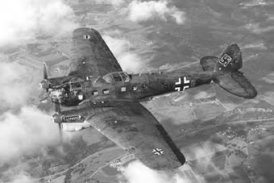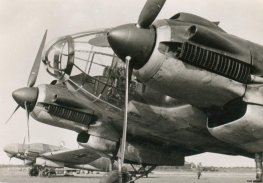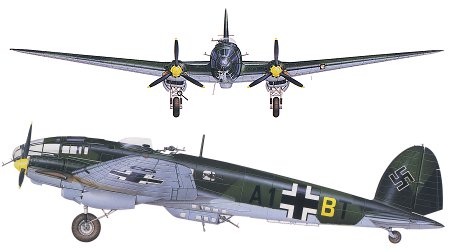
Heinkel He 111
Obsolescent at t he start of World War II and testimony to Germany's mistake is not developing four-engine bombers, the He 111 was nevertheless an effective strike machine. From the Spanish Civil War via the London Blitz and on through every Luftwaffe campaign until the end of 1944, this reliable machine provided the backbone of Germany's air power.
Although considered quite advanced when introduced as a pseudo-airliner, the 'Spaten' - so called because of the spade-like shape of the characteristic Heinkel elliptical wing - quickly became outmoded. But it was tough and serviceable and the Luftwaffe never really managed to find a replacement.
But the spectacle of He 111 bomber formations pressing through swarms of Allied fighters is just part of the story: the He 111 attacked ships with torpedoes and the first guided missiles, towed gliders, dropped secret agents, transported VIPs and hauled high value cargoes.
Many special versions were produced for experimental purposes. One in particular was noteworthy, carrying and launching the Fieseler Fi 103 (V-1) flying bomb from beneath the starboard wing.
Like the Luftwaffe, the military purpose of the He 111 was at first a secret: it was a high speed airliner that could be converted into a bomber. This twin-engine, low-wing aircraft with its glazed nose and elliptical wing was the muscle of Germany's bomber force during the har fought Battle of Britain and even though obsolete it kept on bombing until the war's final days.
 |
 |
 |
| Although the He 111 entered service with Lufthansa in 1936, this ostensible high-speed airliner was actually designed to be a bomber. |
This huge framework was an attempt to deflect barrage ballons cables, but it was too cumbersome and reduced speed. |
He 111s attacked London in large numbers in 1940. After being beaten off by day, they were switched to night raids. |
|
Heinkel He 111 (Technical Specification) |
| Role |
Four or five seat medium bomber |
| Manufacturer |
Heinkel |
| Maximum Speed |
435 kmh (270 mph) |
| Maximum range |
1,950 km (1,200 miles) |
| Ceiling |
8,500 meters 28,000 feet) |
Weight
Empty
Maximum Takeoff |
8,680 kg (19,096 lbs)
14,000 kg (30,800 lbs) |
Dimensions
Wingspan
Length
Height
Wing Area |
22.60 meters (74 ft 1 in)
16.40 meters (53 ft 9 in)
4.00 meters (13 ft 1 in)
86.50 square meters (931 sq ft) |
| Engines |
Two Junkers Jumo 211F-2 inline piston engines each providing 1,006-kW (1,350-hp) |
| Armament |
One 20 mm (0.79 in) cannon
One 13 mm (0.51 in) and up to nine 7.92 mm (0.31 in) machine guns, plus provision for up to 3,307 kg (7,275 lbs) of bombs carried internally and externally |
Photo Gallery
Click here to submit your photo
| Have A Passion For Aircraft? |
|
|
|











